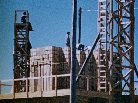
The pile of 108 tons of Composition B (a TNT/RDX mixture) prior to being blown up in the 100 Ton Test (46 K).








If the radiance of a thousand suns |
Last changed 12 March 1999
The first nuclear explosion in history took place in New Mexico, at the Alamogordo Test Range, on the Jornada del Muerto (Journey of Death) desert, in the test named Trinity.
This test was intended to prove the radical new implosion weapon design that had been developed at Los Alamos during the previous year. This design, embodied in the test device called Gadget, involved a new technology that could not be adequately evaluated without a full scale test. The gun-type uranium bomb, in contrast, was certain to be effective and did not merit testing. In addition, since no nuclear explosion had ever occurred on Earth, it seemed advisible that at least one should be set off with careful monitoring to test whether all of the theoretical predictions held.
The origin of the name Trinity for this event is uncertain. It is commonly thought that Robert Oppenheimer provided the name, which would seem logical, but even this is not definitely known. A leading theory is that Oppenhimer did select it, and that he did so with reference to the divine Hindu trinity of Brahma (the Creator), Vishnu (the Preserver), and Shiva (the Destroyer). Oppenheimer had an avid interest in Sanskrit literature (which he had taught himself to read), and following the Trinity test is reported to have recited the passage from the Bhagavad-Gita that opens this page.
May 7, 1945:
To help in preparing the instrumentation for the Trinity shot the "100 Ton Test" was fired on 7 May 1945. This test detonated 108 tons of TNT stacked on a wooden platform 800 yards from Trinity ground zero. The pile of high explosive was threaded with tubes containing 1000 curies of reactor fission products. This is the largest instrumented explosion conducted up to this date. The test allowed the calibration of instruments to measure the blast wave, and gave some indication of how fission products might be distributed by the explosion.
This image was provided by Peter Kuran, director of Trinity and Beyond: The Atomic Bomb Movie (available on video). Footage of the 100 ton shot can be seen in the movie.
| The 100 Ton Test | ||
|---|---|---|
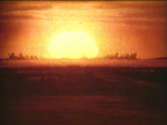 | 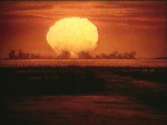 | 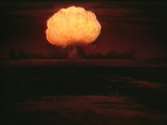 |
July 12, 1945:
The Gadget components arrive at the test site. Assembly of the test device begins at the McDonald Ranch farmhouse at Alamogordo at 1300 hours.
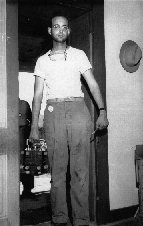
Delivery of the plutonium core (40 K).
Sgt. Herbert Lehr delivering the plutonium core (or more probably half of it) for the Gadget in its shock-mounted carrying case to the assembly room in the McDonald Ranch farmhouse.
July 14, 1945:
Robert Bacher drives the assembled core to Zero, where final assembly of the Gadget was conducted in a canvas tent at the basis of the tower.
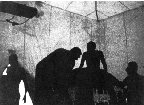
Plutonium core insertion (42 K).
Silhouetted against the canvas, we see the plutonium core being inserted into the explosive shell of the Gadget.
Later that same day, the assembled Gadget (without detonators) was hoisted to the top of the 100 foot test tower.
July 15, 1945:
On the night of July 15th, the detonators were installed in the Gadget, and assembly was completed. Dr. Norris Bradbury, supervising the assembly process noted in his log book: "Look for rabbit's feet and four leaf clovers. Should we have the chaplain down here"?
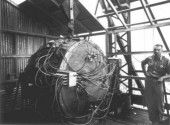 343x250, 26 K | The partially assembled Gadget atop the test tower. Visible in this picture is Norris Bradbury, who later became the director of Los Alamos for several decades upon Oppenheimer's departure. |
| Bigger image (640x472, 71 K) | |
| Biggest image (935x690, 135 K) |
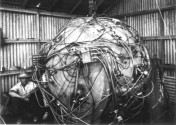 351x250, 33 K | Partially assembled Gadget. |
| Bigger image (640x456, 92 K) | |
| Biggest image (939x669, 142 K) |
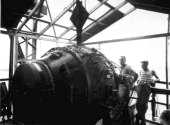 339x250, 21 K | The fully assembled Gadget. |
| Bigger image (640x472, 56 K) | |
| Biggest image (1024x755, 120 K) |
July 16 1945, 5:29:45 A.M. (Mountain War Time)
Trinity Site Zero, Alamogordo Test Range,
Jornada del Muerto desert.
Yield: 20-22 Kilotons
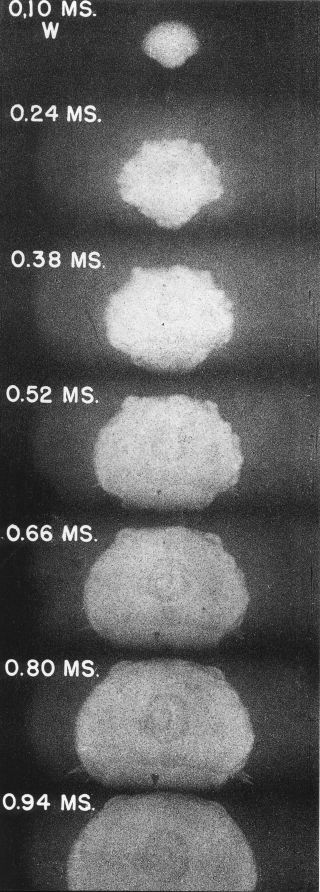 |
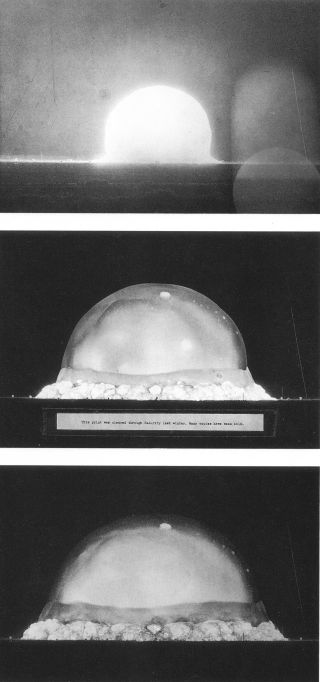 |
| Trinity at 6, 16 and 18 milliseconds. |
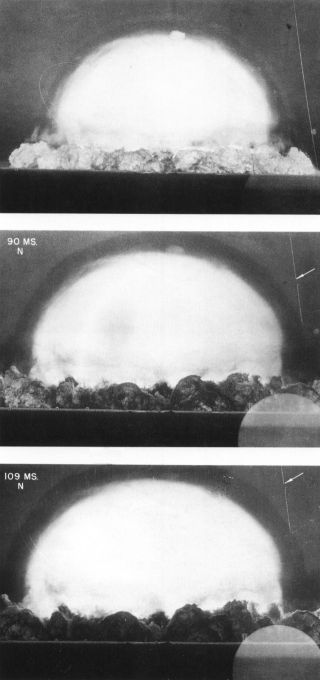 |
| Photos by Berlyn Brixner, LANL. Click on images above for larger views. |
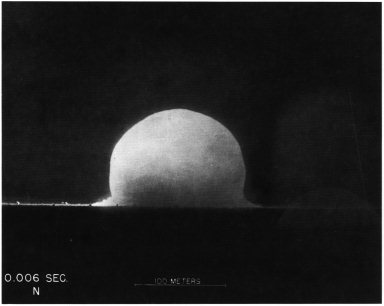 |
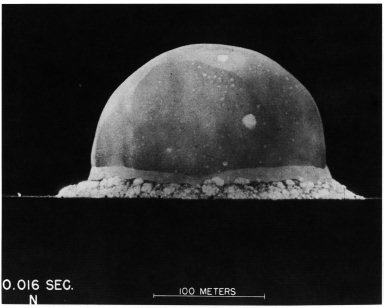 |
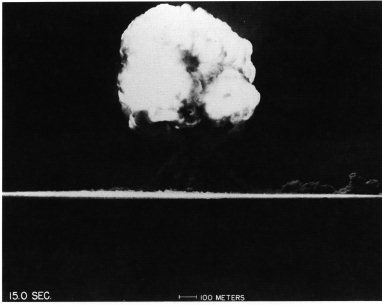 |
"In that brief instant in the remote New Mexico desert the tremendous effort of the brains and brawn of all these people came suddenly and startlingly to the fullest fruition. Dr. Oppenheimer, on whom has rested a very heavy burden, grew tenser as the last seconds ticked off. He scarcely breathed. He held on to a post to steady himself. For the last few seconds, he stared directly ahead and then when the announcer shouted "Now!" and there came a tremendous burst of light followed shortly thereafter by the deep growling roar of the explosion, his face relaxed into an expression of tremendous relief. Several of the observers standing back of the shelter to warch the lighing effects were knocked flat by the blast.
...All seemed to feel that they had been present at the birth of a new age -- The Age of Atomic Energy -- and felt their profound responsibility to help in guiding into the right channels the tremendous forces which had been unlocked for the first time in history."
Brigadier General Thomas F. Farrell, describing his impressions at S-10,000 a bunker 10,000 yards south of Trinity;
quoted in The Day the Sun Rose Twice by Ferenc M. Szasz, pg. 88.
Below is the aftermath of the detonation, about 24 hours later. A dark area of fused soil (trinitite) radiates from ground zero. In the lower right portion of the picture, the crater from the 100 Ton Test is visible.
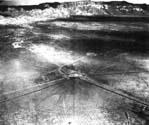 463x388, 48 K | Another view of Trinity ground zero. |
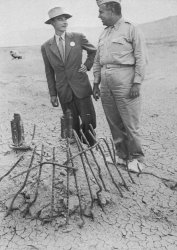 340x480, 40 K | Oppenheimer and Groves inspecting the remains of the Trinity test tower, 9 September 1945. |
| Click for big image (532x750, 86 K) |
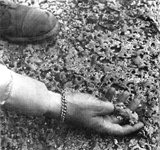 Click for bigger image (500x470, 92 K) | The heat of the Trinity explosion melted the sandy soil around the tower to form a glassy crust known as "trinitite". Years later, with a view towards making the Trinity site a tourist-accessible national historic site (a plan that has never been carried out), the mildly radioactive crust was bulldozed into heaps and covered with soil. |
There is also a full color gallery of trinitite specimens.
For more more videos, pictures, maps, and documents on Trinity, go to Gregory Walker's Trinity Test Page.
To go to the Summary of the Symposium On The 50th Anniversary Of The Trinity Test, Sponsored by National Academy of Sciences (NAS) & DOE; and held at NAS, Sunday, 16 July 1995 Click here.
You can also try downloading the following documents from Los Alamos National Laboratory in Adobe Acrobat (.pdf) format:






